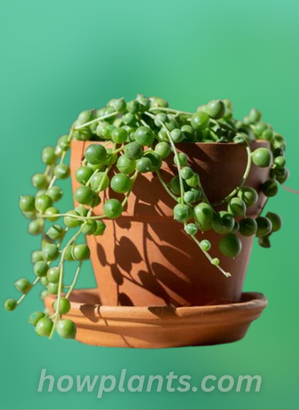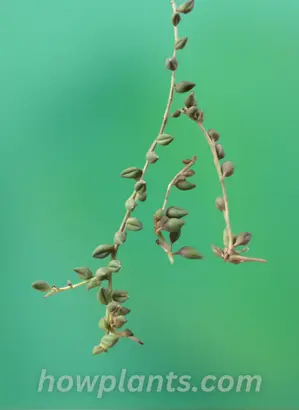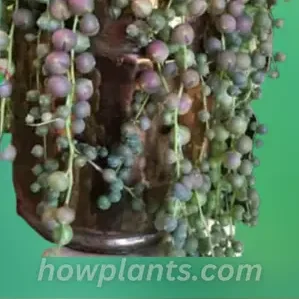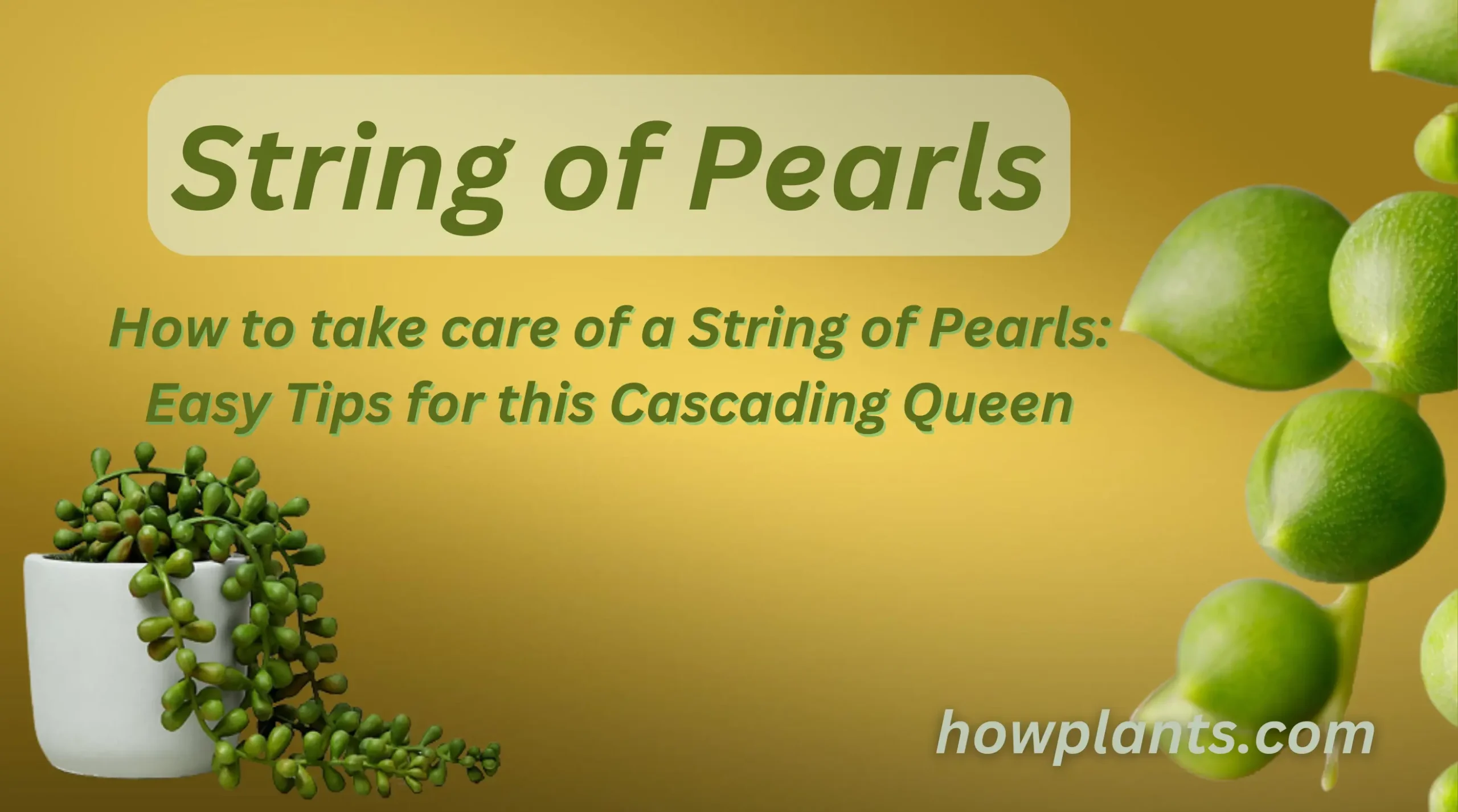Taking care of a String of Pearls succulent is not as complicated as it sounds. With our easy tips and tricks, you can ensure that your cascading queen will stay healthy and vibrant. Learn the basics of how to properly take care of your String of Pearls and keep them looking beautiful for years to come.
The String of Pearls plant, also known as Senecio Rowleyanus, is a unique and beautiful cascading succulent. This cascading queen is a must-have for any plant enthusiast who appreciates its unique beauty. But with its unique needs, it can be difficult to take care of this delicate little plant.
String of Pearl Origin and Habitat
String of Pearl, commonly known as String of Pearls or String of Beads, is an ornamental succulent plant native to the dry regions of South Africa. This evergreen perennial has gained widespread popularity due to its distinctive appearance that features small round ‘pearls’ along thin stems. String of Pearl can be grown both indoors and outdoors in gardens and homes around the world.
Native to the arid countryside around Little Karoo in South Africa, String of Pearl was first discovered by British botanist Leonard Ehrhart in 1786. It grows best in well-drained soil with full sunlight exposure for most part of the day, though it can also tolerate partial shade or some afternoon shade during summer months.
Traits of String of Pearl: Complete Body
There are many traits of the String of pearl plant that make it a desirable plant to have in a garden. This plant is easy to grow and is tolerant of a wide range of conditions. It is a fast-growing plant that can reach up to 3 feet in height. The leaves of the String of pearl plant are large and oval-shaped. The flowers of the plant are small and white, and they are located in clusters at the top of the plant. The flowers of the String of pearl plant are fragrant, and they are used to attract pollinators to the plant.
Environmental Requirements
The string of pearl must be grown in a moist, well-drained soil with a pH of 6.2 to 6.8. It prefers full sun, but can tolerate partial sun or light shade. It is tolerant of drought, but needs regular watering during dry periods. The string of pearl plant is propagated by rooting stem tips or dividing clumps.
How often Water String of Pearls?
The string of pearl plants requires at least 1 gallon of water per week. If you live in a dry area, you may need to water more often. Make sure to water the plant thoroughly and allow the soil to dry out between watering.
Why place a Pearl pot in a water tray?
Putting a string of pearl pot in the water tray will help to keep the water clean and free of debris. The string will also help to keep the pearl pot submerged, which will help to prevent it from becoming damaged.

Temperature Requirements for Pearl Plant
The temperature requirements for a string of pearl plant are as follows:
- The temperature should be between 60-85 degrees Fahrenheit.
- The humidity should be between 50-80 percent.
- The light should be between 6-12 hours per day.
Avoid Mist for String of Pearl
Avoid misting your string of pearl plants with water. This will cause the plant to lose water and may cause it to die. Instead, use a spray bottle filled with room-temperature water to mist the plant.

Soil Composition for String of Pearl
The soil for the string of pearl plants should be composed of a good amount of organic matter, such as compost or manure, and a small amount of sand. The soil should be well-drained and have a pH of 6.0 to 6.8.

How to make String of Pearls grow fast?
This plant is low maintenance and easy to care for, but how can you make it grow faster? Here are some tips on how to give your plant the best growing environment and optimal conditions so that it can thrive!
First and foremost, String of Pearl needs plenty of light. Place the plant near a south-facing window for maximum exposure to sunlight. Additionally, this succulent does not require much water. Watering once every week or two should be sufficient; be sure not to over water the plant otherwise its roots may rot.
What if, Stands of String of Pearl become Long?
If the stands of string of pearl plant become long, it may be difficult to reach the flowers. This could result in decreased pollination and decreased yields. Additionally, the long strings may become tangled and difficult to manage. If this happens, it may be necessary to cut the strings down.
How to grow String of Pearl from the Stands?
There are several ways to grow pearls from the strands of string of pearls plants. If you observe that stands of strings of pearls are becoming large and emerging out of the pots, its the time to grow new plants by using these stands. Cut 5-6 inches of these stands with sterilized knife and sow it in the soil. The cutting will grow into a new string of pearls plants. One way is to take a cutting from the string of pearls plant and place it in water. The cutting will grow into a new string of pearls plants. Other way is to grow the pearls in a saltwater solution. Another way is to grow the pearls in a sugar water solution.

How to Propagate a String of Pearls?
This low maintenance and attractive plant is relatively easy to propagate and grow. To propagate, here are some simple tips for getting started.
Begin by gathering some supplies:
A pair of sharp scissors, potting mix with good drainage properties, an appropriately sized pot and some rooting hormone (optional).
- First, cut off one or two small sections of the plant close to the base. Each section should have several “pearls” attached at the end.
- Dip each cutting into rooting hormone if desired before planting in the soil mixture in the chosen pot. Take a pot with a drainage hole in the bottom and fill it with fresh potting soil.
- Cover the pearls plant with a layer of plastic wrap.
- Place it somewhere with bright but indirect light and keep it lightly moistened.
- Check the pearls plant every few days to make sure it is receiving enough water and fertilizer.
- Once the pearls plant has grown roots, remove the plastic wrap and transfer the pearls plant to a new pot.
Steps to propagate a string of pearls in water?
Propagating String of Pearl in water is a great way to grow this species of succulent. Here are the steps needed to propagate it in water:
- To begin, you’ll need to start with healthy cuttings from an existing string of pearls.
- Cut off 3-4 inches of stem below a node (a bump on the stem which indicates where new leaves will emerge) and use clean shears or scissors for best results.
- Place the cutting into glass jar filled with clean water so that the node remains submerged at all times – this is key for stimulating root growth.
Traits of string of pearls Flower
Some flowers of a string of pearls have traits such as being fragrant, having petals that are smooth and glossy, and having a long stem. Some flowers of string of pearls are also brightly colored.
Tips to get more Flowers of pearls
In order to get more flowers, make sure that the plant has enough light. Place plants in bright indirect sunlight or filtered direct sunlight for at least 6 hours a day in order to bloom properly and produce more flowers. Additionally, you should water your String of Pearls thoroughly but sparingly as too much water can cause root rot and impede flowering.
Best Fertilizers and Requirements of fertilizer
String of pearls plants are low maintenance succulents that require minimal care and attention to thrive. When it comes to fertilizing them, you want to provide the right amount of nutrients in order for your plant to look its best. The best fertilizer for a string of pearls plant is a balanced fertilizer that has an equal amount of nitrogen, phosphorus, and potassium. This will allow your plant to absorb the exact amount it needs for optimal growth without over fertilizing which can damage or even kill your plant. Additionally, string of pearls plants benefit from trace elements such as magnesium and calcium that help promote overall health and encourage blooming.
When using fertilizer on a string of pearls plant, you want to be sure not to overdo it as too many nutrients can burn the leaves or cause root rot.
Problems Associated with Strings of Pearl and their Solutions
String of pearl plants can be a problem if they are not properly cared for. The plants can become straggly and their leaves can become discolored and wilted. If the string of pearl plants are not properly watered, their leaves will become dry and brittle. Additionally, the plants may experience problems with their roots, such as rot. To prevent these problems, keep the string of pearl plants well watered and fertilized, and provide them with adequate sunlight and ventilation.

Do Strings of Pearls are toxic to Living Beings?
This succulent species of the Asteraceae family has been widely popularized due to its attractive, multicolored foliage and its simplicity of care. While the plant is considered safe for humans, animals may be at risk when exposed to it.
Summary:
With its unique and beautiful cascading appearance, the String of Pearls plant is an ideal choice for any plant enthusiast looking to add a touch of class and elegance to their collection. If taken care of correctly, this succulent can bring a lot of joy and beauty to its owner. By following the tips outlined here, any plant enthusiast can be sure to have a healthy and happy String of Pearls in their collection for years to come.
